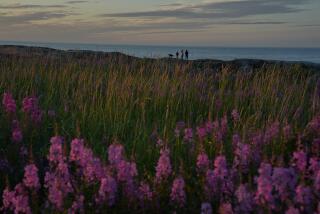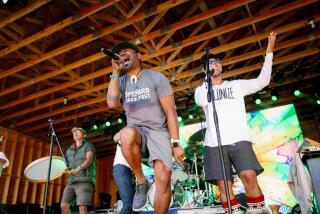Herding reindeer in Canada’s Arctic
Reporting from Inuvik, Canada — Hundreds of reindeer stampeded across the snowy tundra, shaking the ground under my feet like an earthquake. They sent up white clouds as they trotted to join the main herd of 3,000 gathered atop a frozen Canadian lake in minus-18-degree weather.
Kylik Kisoun Taylor, my guide and snowmobile driver, and I had encountered these renegade reindeer as we whizzed around the hilly perimeter surrounding a tundra lake, looking for grizzly bear and wolf tracks.
He swung around behind them and gently coaxed the stragglers away from potential predators and toward the safety of numbers on the wide-open lake.
I hopped off the snowmobile and walked slowly toward the herd, their steamy breath billowing into the bright blue Arctic sky. I stopped 25 yards away and watched them, my heart pounding. They watched me back. Their softly clicking hoofs, low grunting and the muffled crunching of snow were the only sounds.
It was remarkable to gaze across this vast expanse of Santa’s four-legged friends milling about well above the Arctic Circle.
Indigenous business
Kisoun Taylor’s passion — and the motivation behind his company, Tundra North Tours — is sharing transformational experiences such as wrangling reindeer, building and sleeping in an igloo, and getting to know the Canadian Arctic’s indigenous peoples.
“Ever since I first came up north to my mother’s birthplace [Inuvik] I was hooked on the Arctic and knew I had to share my culture and amazing experience with others,” he said.
Kisoun Taylor’s one-of-a-kind experiences persuaded me to join his four-day Arctic immersion in March in the wilderness of the Northwest Territories.
We met at the Inuvik Airport, 120 miles above the Arctic Circle. Kisoun Taylor, one-quarter Inuvialuit (Western Canadian Inuit), one-quarter Gwich’in and one-half Ontarian, cut a dashing figure in a traditional ring seal parka and wolf fur gloves his mother made.
He plunged our group of five into northern culture by zipping us from the airport along 73 miles of smoothly graded ice road that took us past barges, tugs and even a Coast Guard vessel frozen in the Mackenzie River.
Surreal road signs anchored in ice reminded drivers that the official speed limit was 45 mph.
We soon arrived in the former Hudson Bay Co. post of Aklavik, an Inuit hamlet of 800 where youngsters were enthusiastically slapping around a hockey puck on the dirt roads lined with simple houses.
Traditional artist Annie C. Gordon welcomed us into her home. Her living room was adorned with handmade fur mitts, parkas and beaded mukluks as well as snow goggles, caribou-handled knives and half-moon-shaped ulu knives crafted by her husband, Danny C. Gordon, and available for sale. He was out working his fur trap line that day.
Over tea and warm biscuits, Kisoun Taylor spoke about growing up north of Toronto before visiting Inuvik, his mother’s hometown, at age 16. Hunting, fishing and hanging out “on the land” with locals was life-changing.
“These remote Indigenous communities are losing their skills, but their culture is a resource and tourism has the power to harness it,” he said.
He has learned many of those skills and is now teaching them to the local indigenous people so they can also become involved in tourism and be paid to retrieve and re-live their culture.
Igloo encounters
At sunset we made the short trek from the road to our base camp atop the frozen Twin Lakes 10 miles outside Inuvik.
What Kisoun Taylor calls Aurora Igloo Village is a cluster of igloos, an illuminated ice tepee and a canvas trapper’s tent that was to be our cozy communal kitchen and living room.
As we approached we heard the cook, retired teacher Judy Francey, belting an Inuvialuit gospel song while skinning a rabbit for the dinner she was preparing for us on the wood stove.
We enjoyed a casual and convivial dinner with Francey, Kisoun Taylor and his friend, Inuit guide Noel Cockney. Then I bedded down in my first igloo accommodations ever, a modestly comfortable experience complete with candles, a warm sleeping bag and a heated mattress atop reindeer pelts.
I slept soundly, surrounded by ice, until after midnight when Kisoun Taylor woke me up so I could scurry outside and watch the astonishing green and yellow northern lights ripple across the sky.
In the morning, he and Cockney were sawing blocks of packed snow. All of us joined in to help build another igloo, something Kisoun Taylor had to teach himself because locals had lost that skill when they were moved into community housing more than half a century ago.
Then our unlikely group of urban visitors from Montreal, London and Asia had everyone in stitches as we learned to drive snowmobiles, cautiously careering across the sparkling snowy landscape to check on a traditional trap line.
That evening we settled onto warm reindeer pelts in a large igloo to sample a diverse Arctic smorgasbord laid out on a cool, illuminated ice table. We nibbled on reindeer, moose and beluga jerky, muktaq — whale blubber — smoked whitefish, dried char as well as char sashimi, raw and frozen, called quak. I couldn’t help but think how an icy shot of vodka would make a good accompaniment.
Hanging with the herd
At breakfast on our third day, we were all amped up in anticipation of our reindeer escapade. We drove north on the recently opened year-round 86-mile gravel road from Inuvik to Tuktoyaktuk, the first all-weather road to Canada’s Arctic coast.
Then we hopped on the snowmobiles, which we had now mastered, to head inland for 30 minutes. We spotted two foxes before finally encountering Canada’s only free-range herd of reindeer spread across the frozen lake and toward the horizon.
The animals, originally from northern Russia, were imported by the Canadian government in the 1930s by way of Alaska as a potential food source for the Inuit during years when they could not depend on the indigenous caribou migration.
The herd is now privately owned by a descendant of the reindeer’s original northern Scandinavian Sami herders, their meat sold to locals, wilderness lodges and buyers in Yellowknife, capital of the Northwest Territories.
We spent a sunny day patrolling the herd and hanging out amid the reindeer, which are almost identical to local wild and protected caribou. But these creatures are docile, often trained by the Sami and others to pull sleds.
Kisoun Taylor’s plans include adding sledding experiences and a 12-room wilderness lodge with its own landing strip.
We met Tony Lalong, the official reindeer wrangler whose job it is to keep the herd together and protected from predators. In late spring he shepherds them 40 miles west to their calving grounds where they rear their young.
In late afternoon we continued north on the Tuk Highway as it curved through a landscape dotted with frozen ponds. We left behind the Richardson Mountains, the boreal forest shrinking until it vanished at the tree line leaving a panorama of shades of white.
Just before we reached the coast, we spotted surreal-looking pyramids — conical pingos, which are giant frost heaves with ice cores — that glowed magenta in the sunset.
“You haven’t seen the Arctic unless you come in winter,” Kisoun Taylor said.
We reached the Inuvialuit community of Tuktoyaktuk (population 900) after 2½ hours, a hamlet whose town pier was frozen in the sea, its streets swept with blowing snow. Shed roofs were piled high with caribou antlers, and sled dogs peeked from husky huts.
Kisoun Taylor opened the door into the warm, inviting Tuktu B&B where owner Maureen Pokiak was cooking. She was a Saskatchewan teacher who came north for a year in the 1970s and never left, marrying her locally born husband, James, who was away on an overnight musk ox hunt.
We chatted about the new road and the pros and cons of being connected to the rest of Canada as Pokiak served a traditional multicourse Inuvialuit dinner of fish, whale and warm bannock bread.
The meal concluded with a big bowl of reindeer soup. Putting visions of Santa and Rudolph firmly out of my head, I began to eat. It was delicious.
If you go
THE BEST WAY TO INUVIK, CANADA
From LAX,
Three airlines service Inuvik from southern Canada: Canadian North, (800) 661-1505; First Air, (800) 267-1247; and Air North (800) 661-0407
Tundra North Tours’ ([800] 420-9652) four-day Canadian Arctic Reindeer Signature Package can be booked Jan. 1 through April 15. The package includes all meals, hotel, bed and breakfast and igloo accommodations and on-tour transportation. From $4,000 per person.
WHAT TO BRING
Bring warm layers, long underwear and windproof gear. If you like, Tundra North can supply Arctic boots, parkas and snowmobile/ski pants if requested in advance.
TO LEARN MORE
Spectacular Northwest Territories
More to Read
Sign up for The Wild
We’ll help you find the best places to hike, bike and run, as well as the perfect silent spots for meditation and yoga.
You may occasionally receive promotional content from the Los Angeles Times.






